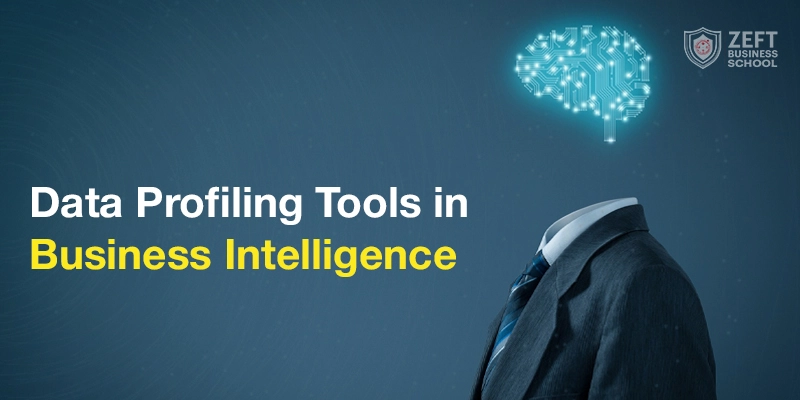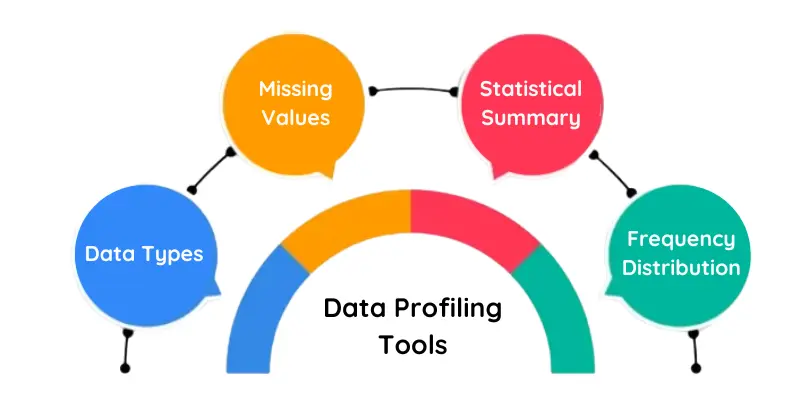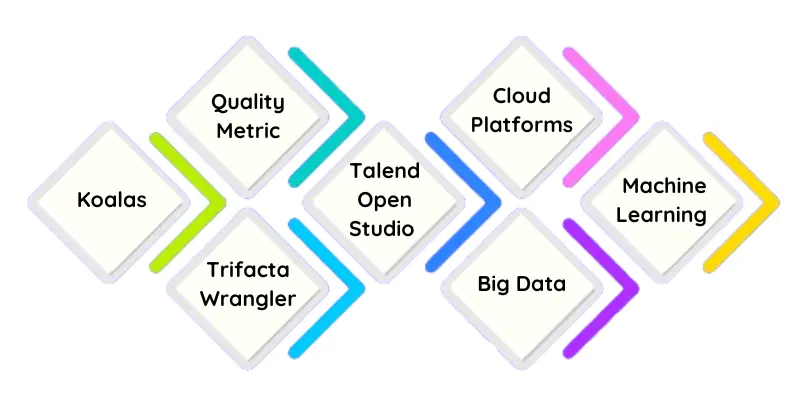Data quality plays a huge role In data analysis, where insights are the gold standard for success, data quality acts as the essential mine. Flawed data, like fool’s gold, throws off your calculations and hinders your ability to make sound decisions. When your data is inconsistent, data profiling can save the day.
This blog dives deep into how data profiling tools work and their functionalities across various platforms like ETL, SQL, and Power BI. We will discover how these tools transform “dirty data” into high-quality data for your analysis, helping you to make better decisions. Before we explore data profiling tools, let’s establish a clear understanding of what data profiling is.
Data Profiling
Data profiling is the investigative technique of examining, analysing, and summarising datasets to obtain insights to assess their quality. It functions as a diagnostic tool, providing precious insights into our data condition.
Data Profiling Across Different Platforms:
Now that we have a solid grasp of what data profiling is let’s delve into how it manifests within specific platforms:
What is Data Profiling in ETL?
ETL stands for ETL (Extract, Transform, Load). These processes often involve working with data from various sources. Database profiling within ETL helps ensure the consistency and compatibility of this data before it’s loaded into your target system.
What is Data Profiling in SQL?
SQL, a powerful database query language, provides built-in functions for database profiling. You can utilise these functions to analyse data types, identify missing values, and uncover outliers within your SQL databases.
What is Data Profiling in Power BI?
Power BI, a popular business intelligence tool, offers a dedicated data profiling section within its Power Query Editor. This section allows you to analyse data quality, distribution, and column profiles, providing a comprehensive overview of your data before building reports and visualisations.
There is a huge demand in companies that handle big data for analysts proficient in data profiling, explore MBA in Data Analytics Scope to know more.
Why are Data Profiling Tools so Crucial?
That’s easy to answer: garbage in, garbage out. Flawed data leads to skewed results and unreliable conclusions. Data profiling tools act as your data guardian angels, meticulously analysing your datasets and revealing:
Data Types
They ensure your data speaks the same language. Integers aren’t mistaken for strings, and dates are formatted consistently. Inconsistency breeds calculation errors and unreliable results.
Missing Values
These tools unveil the presence and distribution of missing entries. Are they scattered or concentrated? Understanding this helps you decide if imputation techniques are needed for a complete analysis. Missing data can distort results and make it more difficult to draw conclusions.
Statistical Summary
Data profiling tools provide a snapshot of your data’s central tendency (mean, median) and spread (standard deviation, minimum/maximum values). This information helps you understand the overall distribution of values within your dataset.
Frequency Distribution
By analysing how often specific values appear, you can identify patterns and potential outliers. This knowledge helps identify patterns and irregularities requiring further investigation. Consider enrolling in MBA B Schools in Chennai to grab a high-paying analyst job with all the necessary skills to get into conglomerates.
The quality of your data is majorly dependent on data profiling, and your workflow can be greatly impacted by the tools you choose. Here’s a breakdown of some popular options across various platforms:
Data Profiling Tools Databricks
Databricks, a popular platform for data engineering, offers built-in data profiling functionalities to get you started:
Display () Function
This function provides a basic overview of your data, including a sneak peek at the first few rows (head) and the data types of each column (schema).
Describe () Function
Delve deeper into numerical columns with this function. It calculates summary statistics, giving you valuable insights into central tendency and data spread.
Databricks API
- This API offers various methods for data exploration, including groupBy(), count(), and orderBy(). These tools allow you to analyse data from different perspectives and identify patterns.
Data Profiling Tools in Python
Pandas Profiling
A user-friendly library offering comprehensive database profiling reports. It generates detailed summaries of data types, missing values, unique counts, and various statistical measures.
DataProfiler
This library simplifies data analysis and sensitive data detection. It automatically loads and formats data into DataFrames and identifies schema, statistics, and potential privacy concerns.
Data Profiling Tools in Azure
Azure Data Catalog
While retiring soon, it’s worth mentioning. It offered data profiling capabilities for registered data sources in Azure SQL Database, Oracle, Teradata, and Hive tables. (Consider Microsoft Purview as an alternative)
Microsoft Purview (Successor to Azure Data Catalog)
This comprehensive data governance solution provides database profiling features, analyzing and summarizing data within your Azure data landscape.
Data Profiling Tools in SQL Server
SQL Server Integration Services (SSIS) Data Profiling Task
This built-in tool analyses source data, identifying data types, value distributions, and potential quality issues. It helps you streamline data cleansing and transformation within SSIS workflows.
Data Profiling Tools on Gartner Peer Insights
Gartner Peer Insights is a platform where users can review and compare various data profiling tools. It allows you to research and identify tools based on user experience and ratings, catering to your specific needs.
Data Profiling Tools from Microsoft
Power BI Data Profiling
This built-in feature within Power Query Editor allows you to analyse data quality, distribution, and column profiles. It empowers you to assess data health before creating impactful reports and visualisations in Power BI.
Azure Databricks Data Profiles
Databricks, a popular Apache Spark-based platform, offers database profiling capabilities through the cell output UI or the dbutils. data. Summarise function. This functionality provides summary statistics and data distribution insights for your datasets.
Data Profiling Tools in Snowflake
Snowflake, a cloud-based data warehouse, offers built-in data quality features. While not strictly data profiling tools, these functionalities will let you examine data quality via techniques like figuring out null values and analyzing data distribution.
To master all these technical data profiling tools, consider them learning them from best MBA Colleges in Chennai.
Third-Party Data Profiling Tools
While the aforementioned tools offer a solid foundation, venturing into more specialised options can cater to specific needs:
Koalas
This open-source library brings the familiar power of pandas profiling methods to Apache Spark. Leverage familiar techniques within the Databricks environment.
Quality Metric
This library provides detailed data quality reports, including data type inconsistencies, missing values, and potential errors. Obtain a deeper understanding of data analysis.
Trifacta Wrangler
This easy-to-use application’s visual interface for data profiling appeals to people with varying technical backgrounds.
Talend Open Studio
This open-source platform provides a comprehensive suite of data integration tools, including database profiling capabilities.
Data Profiling for Big Data
When dealing with massive datasets, scalability becomes paramount. Tools like Apache Spark Profiler and Amazon Redshift Spectrum offer profiling capabilities specifically designed for Big-Data environments.
Data Profiling for Cloud Platforms
Workflows inside their respective ecosystems are streamlined by the built-in database profiling functionalities and data management features offered by cloud platforms like Azure Purview and AWS Glue Data Catalog.
Data Profiling for Machine Learning
When data is the fuel for your machine learning models, ensuring its quality is even more critical. Specialized tools like Pandas-Profiling and Feature tools offer functionalities tailored to identify biases, data leakage, and potential issues impacting model performance.
By exploring these options and understanding their functionalities, you can choose the data profiling tools that best suit your specific platform and data analysis needs. Remember, a clean and well-profiled dataset is the cornerstone of reliable and insightful data analysis. To master data profiling tools better consider taking up a professional degree in MBA Institute Near Me.
Data Profiling Workflow
Here’s a step-by-step guide to utilising data profiling tools in Databricks:
- Load Your Data
Welcome your data aboard using Databricks functions like spark.read.csv() or spark.read.json() to load your data into a DataFrame.
- Get a Basic Overview
Utilize the display() function to visualise the first few rows and understand the schema.
- Perform Exploratory Data Analysis (EDA)
Employ Databricks API methods like describe(), groupBy(), and orderBy() to delve deeper into the data and uncover patterns.
- Leverage Third-Party Tools
For a more comprehensive analysis, consider using libraries like Koalas or QualityMetric.
- Clean and Prepare Your Data
Based on the profiling results, address missing values, handle outliers, and format inconsistencies to ensure data quality.
Advantages of Data Profiling
By leveraging data profiling tools, you can unlock numerous benefits:
- Improved Data Quality
Data profiling identifies and addresses issues like lacking values, inconsistencies, and outliers. This leads to purifiers and more reliable statistics for analysis, in the end yielding more accurate outcomes and informed decision-making.
- Enhanced Data Understanding
Gain valuable insights into the structure and content of your data. This deeper expertise helps better decision-making by revealing patterns and trends within your datasets.
- Streamlined Data Preprocessing
Database profiling allows pinpoint regions requiring statistics cleaning and transformation. This streamlines the data prep process, allowing you to spend less time wrestling with the stats and extra time extracting insights.
- More Effective Data Mining
High quality data, profiled using these tools, ensures your data mining efforts are built on a solid foundation. This translates to much accurate and actionable insights, empowering you to uncover hidden patterns and make data-driven predictions with greater confidence.
Data Profiling in Automation and Machine Learning
The future of database profiling lies in automation and leveraging machine learning (ML) for deeper insights. Here’s a glimpse of what’s on the horizon:
Automated Data Profiling
As data pipelines evolve and become more complicated, automated data profiling tools will become increasingly important. These tools can constantly reveal data quality and alert users to potential problems.
Machine Learning-powered Anomaly Detection
ML algorithms can be skilled to perceive unusual patterns and potential outliers in your data, helping you focus on areas requiring further investigation.
Data Quality Self-Service Platforms
The upward thrust of self-service analytics platforms will raise data profiling talents to a broader range of customers in agencies, democratising data quality management. To know more about data quality management, check out our previous blog on “Why data quality matters?”.
Database profiling serves as the cornerstone for dependable analysis and informed choice-making. By leveraging the power of data profiling tools, you can transform raw data into a defined narrative, paving the way for accurate insights. Whether you choose the integrated functionalities of Databricks, explore third-party options, or project into specialised tools; database profiling empowers you to release the overall potential of your information. If you are passionate in business and analytics, consider pursuing MBA Data Analytics in Chennai.
By integrating data profiling into your data pipelines and adopting a proactive method, you may ensure your records remain a dependent source for riding success throughout your employer.




